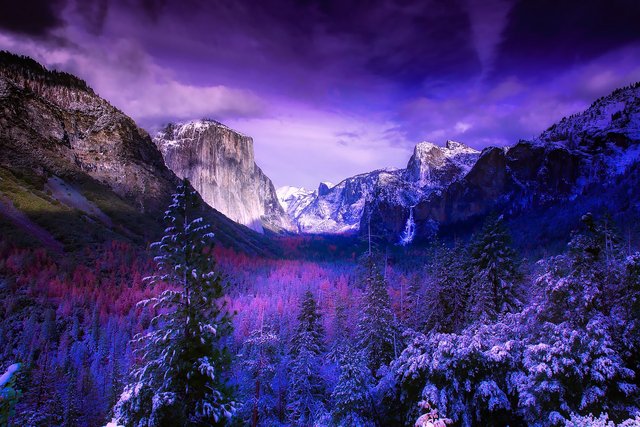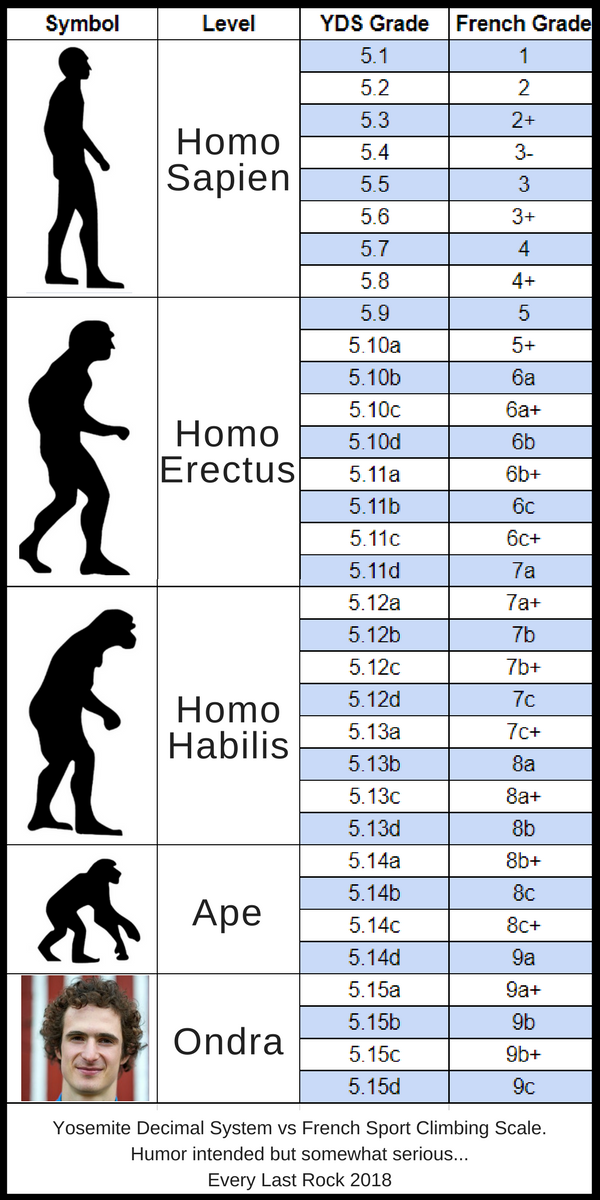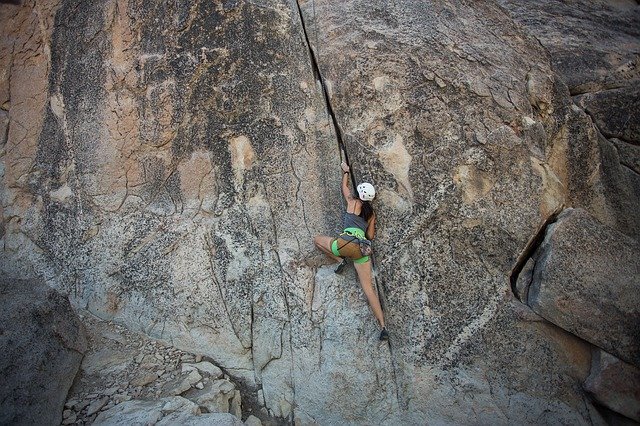Yosemite Decimal System
What is a 5.9 and why can't I climb it? Why are there no 5.0s in the gym? What does 4th class mean?
Welcome to the in-depth discussion on the Yosemite Decimal System (YDS) where we will try to answer all the most common question about this complex grading scale.
Please join in with the discussion below to add your own expertise on the subject.

History of the Yosemite Decimal System
The origins of the Yosemite Decimal System can be traced back to the 1930's were the forefathers of American climbing were pioneer mountain climbs in the High Sierras. This system was very basic and only compared climbs and hikes to one another. So if you can imagine, the scale would simply be staying that Climb1 is harder than Climb2 but easier than Climb3. Keep in mind that this was before free climbing was popular and most climbs were done with the use of aid devices.
The main segments of the scale at this time was split into 5 classes: class 1, class 2, class 3, class 4, and class 5. These classes were used to describe the difficulty and protection need to each climb. Class 1 is a general hike and Class 5 need ropes and technical expertise to complete (we will expand on this later).
Around 20 years later in the 1950's, the system was modernized into what we see today. This was done by climbers in Southern California climbing at Tahquitz Peak. These climbers were pushing the limits of climbing at the time and decided to divide each class into different divisions.
This first time the Yosemite Decimal System was used in the same fashion it is today was to describe 10 climbs in the Tahquitz Peak region. These 10 climbs ranged from 5.0 to 5.9 (yes in 1950, 5.9 was the hardest grade out there).
Notable ascents using the YDS are as follows:
- The Trough 5.4 by Jim Smith, Bob Brinton, and Z. Jasaitis in 1936
- Angel's Fright 5.6 by Jim Smith and Bill Rice in 1936
- The Mechanic's Route 5.8 by Dick Jones and Glen Dawson 1937
- Open Book 5.9 by Royal Robbins and Don Wilson in 1952 (Free)
Over the next 10 years it became apparent that with advancements in climbing gear, techniques, and physical fitness, the scale would need to be opened up to more and more difficult climbs.
Instead of retooling all the grades of the last 20-30 years climbers decided to make the YDS an open-ended scale. This opened up new difficulty grades for climbers (5.10, 5.11, 5.12 etc.).
An issue with this new open-ended scale was quickly discovered when strong arms like John Long, John Gil, and John Bachar (dang, John must be a good climbing name) quickly pushed the limits of human capability. It was universally decided to further segment the grades above 5.9 with a suffix of "a" to "d".
Grades between 5.11 and 5.12 would now be 5.11a, 5.11b, 5.11c, and 5.11d. This better helped first ascensionists describe the exact difficulty of the climb.
More history information can be found here.
What do the YDS Grades Mean?
Earlier we stated that the original YDS scale was split up into 5 distinct classes. Let's go over this in some more detail.
Yosemite Decimal System Classes
- Class 1 - A low risk, generally flat hike. Chance of injury for a Class 1 hike is commonly just a sprained ankle or bug bite. The physical fitness required for a Class 1 hike is very low. These types of hikes could also be considered general hiking.
- Class 2 - A steep hike. A Class 2 hike is will be steep enough to get your heart pumping and require you to be careful about where you steep. The danger is not intimate, but if you really mess up you could be hurt. Hands are not necessary at any point during the hike.
- Class 3 - A very steep hike. Section of this hike will require the use of your hands. You won't have to use your hands to move upward, but only to balance. A fall during a Class 3 hike would result in a serious injury. Having proper footwear and good fitness is recommended.
- Class 4 - A scramble. Hands are required to move up the wall at times but never need to bear weight. Durning a Class 4 scramble you will always be able to take your hand off the wall and stand or sit. Falling during a scramble will result in very serious injury and potentially death. Extreme expertise is recommended before attempting a Class 4.
- Class 5 - A Rock Climb. What most people are interested in. Hands will be supporting full body weight for portions of the climb. A Class 5 climb required protection from a rope and anchors. A fall during a Class 5 climb will result in ground fall and most likely death. Intense training and knowledge of gear are required to attempt a Class 5 climb.
A conversion scale for Class 5 Rock Climbing:

Class 1, 2, and 3 Hiking Today
Most people in America today have been on a hike at one point in their lives. The Nation Parks Service has seen a massive influx of visitors to the many National Parks over the last 10 year.
The #1 activity done in these parks is in fact, hiking. So why is it that we don't see hikes rated in the Yosemite Decimal System?
Simply, most people don't know what the YDS is and would be less likely to do on a hike due to uncertainty.
Most parks have come up with a more generalized and family-friendly scale to describe the difficulty of a hike. If you look at the list below you will see how the YDS is actually disguised as a simple easy, medium, hard scale.
A typical park hiking scale will look something like this (shown with equivalent YDS Classes):
- Easy - Class 1
- Moderate - Class 2
- Strenuous - Class 3
Make sure to think about this the next time you go on a hike in a busy National Park. You might look really cool talking with your friends about that sick Class 2 you did yesterday.
Class 4 Scrambling
Scrambling is its own subsection of climbing. It's where hiking meets rock climbing.
Class 4 Scrambling can often be done without a rope or any other protection. It requires you to be extremely careful and level-headed.
Scrambling is typically divided into 3 separate categories of difficulty: Easy, Moderate, and Difficult.
If you do any Alpine Climbing or route climbing in the mountains you will notice that some approaches are graded Class 4. This means that you must complete this Scramble before going onto your 5th Class climb.
Scrambling can also be its own sport. Many climbers choose to go out and scramble for the day to get long hours of easy moves in without the need for serious gear.
Class 5 Rock Climbing
This is where the fun starts!
Class 5 Climbing is what most people consider real rock climbing. Ranging from 5.0 to 5.15d there are over 30 different difficulty levels in this system.
Although this is difficult and completely subjective we will try to explain each grade and the strength required to climb it.
- 5.0 to 5.6 (Very Easy) - A complete beginner would be able to climb it. "Jug Ladder" would be a slang term synonymous with this grade.
- 5.6 to 5.9 (Easy) - After a month or two of climbing in the gym and training your upper body this grade range will be possible. A very fit person might be able to climb this without ever training.
- 5.10a to 5.11a (Moderate) - A good deal of training and practice is required to climb at this level. Most climbers will be able to climb to this level in less than a year after starting climbing.
- 5.11b to 5.12b (Hard) - You will have to be serious about climbing for over a year to climb at this grade. V3 toVcruxesxs are common. Moves start to get harder and routes are often overhung and longer. Stamina will often be the crux.
- 5.12b to 5.13a (Harder) - Moves start to be the crux. In Bouldering terms, you might see V5to V7 moves at times. Training in Power Endurance is recommended.
- 5.13b to 5.14a (Advanced) - You have left your friends behind. V8 and V9 cruxes are not uncommon. Most people won't ever make it to this level. You won't be waiting in line to climb this routes. Respect for those who make it to this level.
- 5.14b to 5.14d (Elite) - These climbs become hard to find. Travelling to climb at this level is expected. Cruxes are extremely difficult and rest become less likely. Your getting close to sponsorship!
- 5.15a to 5.15d (Pro) - The 1%. Insanely hard and futuristic for the masses. Most of these climbers are sponsors and climb full time. It should be noted that Adam Ondra could have his own category as he is leagues ahead of everyone else.

YDS Roman Numeral Grade
With some of the big wall and more gear intensive climbs, there is a Roman Numeral Grade at the end. This grade refers to the expected length of the climb.
This is important for planning sufficient amounts of water and food for the climb.
The scale goes as follows:
- I - Less than 2 hours
- II - Less than half a day
- III - Most of a day
- IV - An entire day
- V - About 2 or 3 days
- VI - Less than a week
- VII - More than a week
YDS Protection Scale
Also known as the Sketchy Factor, the Yomesite Decimal System also has a factor to determine how scary and dangerous a route is.This could be due to bad gear placement, hazardous falls, long runouts or bad, flaky rock. Determining the Protection Grade can be more subject than the difficulty grade. That being said, make sure to do your research before trying something that gets one of these ratings.
- PG-13 - Has so sections that will make your heart race. The real danger is probably only mental. Long falls are possible but ground fall is unlikely
- R - Long Runouts. Protection is space out and falls will result in long whips. Broken bones possible even when properly protected.
- X - Protection is virtually non-existent. Falls could result in serious injury or even death. Basically a free solo.
Notable First Ascents using YDS
If there is interest in this subject we will include some of the most epic ascents in route climbing history. If you would like us to put together this list please leave us a comment below telling us so!
Final Thoughts
Just like any subjective scale, there are always issues. The Yosemite is one of the many grading systems used to describe the difficulty of climbing.It does a good job. It makes us push out limits and keeps us from getting into a bad situation.
If you have anything to add or correct please let us know in the comments.
Keep Crushing!
Original post : https://every-last-rock.com/yosemite-decimal-system/
Damn dude! Sold writeup on the YDS scale. I think you laid it out pretty clearly to a point where someone could probably go to the gym and not be totally confused. Well done!
There can be a lot of information in an crag guidebook, and this definitely makes everything more approachable.
Thanks so much for the love! I'm glad you like it.
I found that the internet was lacking a good explanation so I figured I'd give this a try.